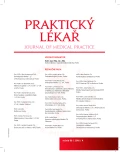Genotype/phenotype correlation in Czech tuberous sclerosis patients
Authors:
H. Filipová 1; R. Vrtěl 1; R. Vodička 1; B. Petrák 2; V. Curtisová 1; M. Procházka 1
Authors‘ workplace:
Ústav lékařské genetiky FN a LF UP, Olomouc
Přednosta: prof. MUDr. Martin Procházka, Ph. D.
1; Klinika dětské neurologie 2. LF a FN Motol, Praha
Přednosta: prof. MUDr. Vladimír Komárek, CSc.
2
Published in:
Prakt. Lék. 2016; 96(4): 185-189
Category:
Of different specialties
Overview
Tuberous sclerosis complex is a genetic disorder that is manifested by benign tumours in many tissues and organs (particularly of the skin, brain, kidney, heart). Pathogenic mutations are in TSC1 and TSC2 gene. This study is focused on phenotype/genotype correlation. In the group of 99 probands were found 75 mutations in TSC2 gene and 24 mutations in TSC1 gene. Phenotype/genotype analysis of a group of 118 patients revealed that TSC2 mutations are associated with more severe phenotypes than TSC1 mutations. Furthermore, there were found significant correlations between findings of hypomelanotic spots and the incidence of cortical tubers, the facial skin involvement (angiofibromas) and evidence of renal angiomyolipomas, between hamartoma of the retina and heart rhabdomyoma, or between epilepsy and mental retardation in the group of patients with TSC2 mutations. Conversely, in individuals with TSC1 mutations have been rarely observed angiomylipomas and multiple renal cysts, fibrous plaques forehead and hamartoma of the retina. No statistically significant correlation was observed between different types of mutations and specific phenotypes.
Keywords:
complex of tuberous sclerosis – TSC1 gene – TSC2 gene – sequencing, phenotype/ genotype correlation
Sources
1. Curatolo P, Moavero R, Roberto D, Graziola F. Genotype/phenotype correlations in tuberous sclerosis complex. Semin Pediatr Neurol 2015; 22 (4): 259–273.
2. Dabora SL, Jozwiak S, Franz DN, et al. Mutational analysis in a cohort of 224 tuberous sclerosis patients indicates increased severity of TSC2, compared with TSC1, disease in multiple organs. Am J Hum Genet 2001; 68(1): 64–80.
3. European Chromosome 16 Tuberous Sclerosis Consortium. Identification and characterization of the tuberous sclerosis gene on chromosome 16. Cell 199331; 75(7): 1305–1315.
4. Foster K, Acosta-Jaquez HA, Romeo Y, et al. Regulation of mTOR Complex 1 (mTORC1) by Raptor Ser863 and Multisite Phosphorylation. J Biol Chem 2010; 285(1): 80–94.
5. Gómez MR, Sampson JR, Whittemore VH. Tuberous sclerosis complex. Developmental perspectives in psychiatry. New York: Oxford University Press, 3rd ed., 1999: 313–316; 11.
6. Northrup H, Krueger D. The international tuberous sclerosis complex consensus group. Tuberous sclerosis complex diagnostic criteria update: recommendations of the 2012. International tuberous sclerosis complex consensus conference. Pediatr Neurol 2013; 49: 243–254.
7. Sancak O, Nellist M, Goedbloed M, et al. Mutational analysis of the TSC1 and TSC2 genes in a diagnostic setting: genotype-phenotype correlations and comparison of diagnostic DNA techniques in tuberous sclerosis complex. Eur J Hum Genet 2005; 13(6): 731–741.
8. van Slegtenhorst M, deHoogt R, Hermans C, et al. Identification of the tuberous sclerosis gene TSC1 on chromosome 9q34. Science 1997; 277: 805–808.
9. Vrtel R, Verhoef S, Bouman K, et al. Identification of a nonsense mutation at the 5‘ end of the TSC2 gene in a family with a presumptive diagnosis of tuberous sclerosis complex. J Med Genet 1996; 33(1): 47–51.
Labels
General practitioner for children and adolescents General practitioner for adultsArticle was published in
General Practitioner

2016 Issue 4
Most read in this issue
- The purpose of MRI as a part of pre-surgery staging for breast cancer
- Genotype/phenotype correlation in Czech tuberous sclerosis patients
- Preview of physical activity in selected cancer patients
- Occupational diseases reported in the Czech Republic in 2015
